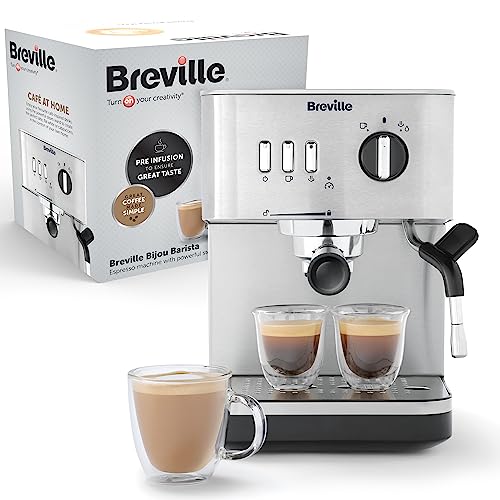How Does Machine Espresso Work?
The machine espresso uses precise pressure, as well as a filtering technology that is amazing to create the coffee you love. How exactly does it work?
Espresso is produced by pushing hot water under pressure through finely-ground coffee. The process is similar to making drip coffee. However www.coffeee.uk is the major difference.
The Head of the Group
The group head is the portafilter you place in the espresso maker when making it. It is responsible for dispersing water into the portafilter before controlling the pressure of the extraction. There are many different kinds of group head, each with their distinct advantages and drawbacks. Some focus on temperature stability, whereas others on pre-infusion capabilities, while others are designed to control the lever. There are even some that have a combination of features, such as the E61 that is the most popular choice among baristas due to its ability to offer multiple perks in a single package.
As you can see from the above photo, the group head is fitted with a variety of notches. It is possible to place your portafilter inside these notches, and then twist the head to secure it. There is also a gasket of rubber that is a part of the notches, which helps create an airtight seal when you insert your portafilter into the machine. The notches on the head allow for an exact location of the portafilter which is vital to ensure a consistent extraction.
Apart from allowing you effortlessly insert your portafilter the group head is also responsible to maintain an even temperature. This is accomplished by cycling hot water around the portafilter and through the brew-basket, ensuring the temperature is always right to extract the coffee. This is crucial, since just a few degrees could make the difference between a good and great espresso.
The Pump
In contrast to manual piston machines that use a lever to pressurize water, the rotary espresso machines use motorized pumps to provide the nine atmospheric bars of pressure needed for espresso extraction. The pressure is built by pumping water through a heat-exchanger and then through the ground coffee.
Pumps tend to be cheaper than piston-driven machines and tend to last longer, however both types of machine can degrade with overuse and insufficient cleaning. Pumps are also more complex mechanically, which can raise the cost of even the simplest models.
Certain espresso machines eliminate the pump completely and instead employ steam pressure to create espresso. This could lead to over-extraction since the boiler that makes steam also warms the water to boil. They also have to continually rebuild their pressure between cups. This takes energy and time.
Many espresso machines employ an rotary or vibrating pump, which is a vibration model using a vibrating disc to create pressure and an rotary model that pushes hot water through the grounds at high speed. Both models can produce an excellent espresso, however the rotary models are quieter and more durable than vibration pumps.
The Boiler
The boiler makes the water warm to the right temperature to extract. The resultant steam then reaches the portafilter which holds ground espresso beans and is then pumped down into the cup. The steam creates enough pressure to push the grounds of the coffee through. This creates a layer crema that is then poured over. This is one of the hallmarks of a great espresso.
There are three types of espresso makers, which differ in the kind of pump they use and how hot the coffee is. There are a variety of ways in which the brew can be controlled and the size of the cup that the machine is capable of making.
The first espresso machines were steam-type. They employed a single boiler to make both steam and brew but the pressure they could create was minimal - two bars of atmospheric pressure maximum. The coffee tasted bitter and burned. The modern espresso machine was developed by the Milanese producers Luigi Bezzerra & Desiderio Pavoni.
The most popular espresso maker is a semi-automatic one with an electric pump. This is what people envision when they imagine an espresso machine. With a semi-automatic machine you have to grind the beans and tamp them by hand, but the pump is able to regulate the flow of water and pressure. This is a great compromise between the human touch and mechanized consistency.
The Filter
Espresso machines usually use a filter that separates the coffee grounds from the hot water. The filter is also a vital part of the machine's temperature control, as it prevents overheating.

A filter can also help with flavor as it allows for a longer flowering period. This helps the beans release their flavors and provides an opportunity to improve extraction.
It is important to remember that even the most efficient filter can make a bad cup of coffee. The quality of the beans, as well as the extraction, remain vital.
It's here that the magic takes place. This is what makes espresso taste so good. The grouphead, sometimes called the brew head, is the place where the portafilter (the thing you put the coffee grounds into) is placed when you're making espresso.
Steam-driven espresso machines use hot water that is heated in an airtight vessel to create steam. The steam then pushes hot water through coffee grounds under high pressure. These machines are less expensive and easier for the user to maintain than pumps-driven models. They are however limited in their ability to create the perfect brewing conditions as they only operate with 1-1.5 bar of pressure. The perfect shot requires 9-10 bars.
In recent times, espresso machines powered by compressed air-pump have become increasingly popular. They use an air compressor to force hot water into the ground and are more mobile than steam-driven electric espresso machines.
